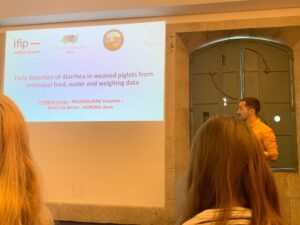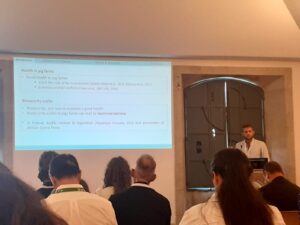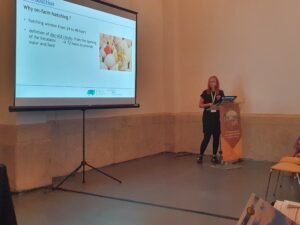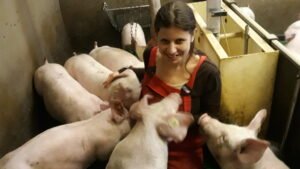The European Federation of Animal Science (EAAP) Annual Meeting gave an opportunity for the application of new ideas in practice through many parallel sessions, a plenary meeting, poster presentations, and discussions about scientific achievements in livestock production all around the world.
Researchers from the HealthyLivestock project presented and participated in this privileged discussion forum where the research community met with the industry, to discuss and plan for how to address the multiple challenges that animal science sector has to cope with in the upcoming years.
Read here the abstracts of the presentations :

Johan THOMAS, Research engineer for livestock housing & energy, Breeding service – French Institute for pig and pork industry
“Early detection of diarrhoea in weaned piglets from individual feed, water and weighing data”
J. Thomas, Y. Rousselière, M. Marcon and A. Hémonic
This study, part of HealthyLivestock project, aims to analyse individual water and feed consumption related to weight of weaned piglets and their link to diarrhoea. Data were collected from 15 batches of 102 piglets using specific automata (connected feeders and drinkers, automatic weighing scales, RFID ear tags) and observations of piglets’ health status made by specialized technicians. Analyses were carried out every week on the 138 healthy animals compared by weight category (light, medium, heavy). The average feed consumption had no significant difference between categories whatever the week and was close to 4% of the live weight. For the average water consumption according to weight, it was close to 10% and there was no significant difference between groups. However, at the end the water consumption of one heavy pig gave significant difference with the light group. These overall stable averages in healthy pigs, were promising for distinguishing deviant behaviours of sick pigs. However, they shaded the high intra-individual variabilities, around 40% at the beginning of post-weaning for both feed and water consumption and almost 16% for feed and 25% for water at the end. Then, the comparison between healthy and diarrheic piglets showed no statistical difference for average water consumption on the day of the first clinical signs and even 1 and 2 days before. In contrast, the average feed consumption had a very significant difference (P≤0.001) for days 5-7 after the weaning and a significant difference for day 8 (P≤0.05). These differences were also significant for data collected 24-48h before first clinical signs. This means either those diarrheic piglets decreased their feed consumption the first days after weaning or that it is because they eat less when they become diarrheic. As feed consumption seemed to be an interesting indicator to detect early diarrheic weaned animals, we continued the study by using machine learning methods. But they all failed in detecting individually diarrheic animals from water and feed consumption related to weight, probably because of considerable individual variability of feed consumption, even in healthy pigs. To improve these results, new data are collected, like location of piglets in the pen by image analysis.

Pierre LEVALLOIS, Agronomist – PhD student in animal health (pig husbandry), INRAE
“From biosecurity audit to tailor-made recommendations in pig farms: how to prioritize action points?”
P.Levallois, M. Leblanc-Maridor, C. Belloc, C. Fourichon
Different audits have been developed to assess biosecurity in pig farms. Recommendations formulated by veterinarians from these audits aim at improving disease prevention.
A prioritization needs however to be done among unimplemented practices to enhance compliance on targeted action points. This leads to formulate biosecurity recommendations which are tailor-made (i.e. adapted to the farm context) and not systematic (i.e. selected and targeted among all the unimplemented practices). The process allowing to understand this prioritization is not explicit. The aim of this study was to analyse possible reasons allowing veterinarians to select recommendations and define a tailor-made biosecurity plan with specific action points. Biosecurity (internal and external) audits from the European project HealthyLivestock were performed in 20 farrow-to-finish pig farms in western France.
Each audit was performed by one person in the presence of the farmer and the veterinarian. Prioritized recommendations were formulated among unimplemented practices by the farm veterinarian at the end of the visit and recorded. Information about pathogen statuses and current health disorders were also collected. Unimplemented practices were categorized according to their theoretical expected effect on prevention, financial cost and time cost. For each farm, unimplemented practices were classified according to these categorizations. Matching of recommendations with unimplemented practices was analysed, accounting for these categories and for the available health information.
Recommendations can target unimplemented practices, with different expected effect (from high to low) on disease prevention according to the pathogen statuses and current health disorders of the farm on top of financial and time costs. This study underlines the importance of integrating the health context in audited farms to provide tailor-made biosecurity recommendations.

Julia Malchow, Doctor of Agricultural Science, Friedrich Loeffler Institute
Effects of hatching system and enrichment on broiler chickens’ behaviour
Julia Malchow , E. Tobias Krause , R. Molenaar, Mona F. Giersberg , Lars Schrader
After hatching in commercial hatcheries, chicks usually have no access to water and feed for 24 to 48 hours. This can lead to decrease post-hatch development and impair animal welfare. One alternative to avoid this problem is on-farm hatching.
Enrichments of the housing environment can be offered to further promote animal welfare. To investigate the influence of hatching system and additional enrichment on behaviour, 320 mixed-sex broilers were kept in a 2 x 2 design (hatchery-hatch vs on- farm hatching x barren environment vs enriched). Environmental enrichment was provided by elevated structures (plastic grids). Individual chickens were tested twice, in an arousal test (test arena in the pen, duration: three minutes) on day 5 and in an open field test (test arena outside the pen, duration: five minutes) on day 25 of life. Latency to first move, number of field changes, and amount of defecation were recorded. Additionally, enrichment usage in the pens was analysed throughout the cycle. Statistical analyses were done with linear mixed-effect models using nlme package in R and we tested for correlations of test parameters between day 5 and 25. The usage of elevated structures was higher in on-farm hatched than in hatchery- hatched chickens (P = 0.0312). On day 5, chickens hatched on-farm showed a longer latency to first move compared to the hatchery-hatched birds (P = 0.0052). At day 5, chickens from barren environment tended to show more field changes than animals kept with enrichment (P = 0.08) in the arousal test. On day 25, chickens from the enriched environment showed more field changes (P = 0.016). Only a weak correlation was found between day 5 and day 25 in the latency to first move (r P = 0.134, P = 0.017). Both treatments affected different behavioural traits, parameters in various extent: on farm hatched chickens showed more fear in early life. Furthermore, chickens kept in a barren environment were more active.

Katarina Bučková , Research Assistant, School of Biological Sciences, Queens University Belfast
Effect of novel enrichment on pig resilience
K. Bučková , R. Muns , J. Ceron 3 , I. Kyriazakis
Most pigs in slatted systems are provided with enrichment meeting only minimum legal requirements. We aimed to explore the effects of novel enrichment for pigs in slatted systems, and to investigate the timing of enrichment provision on stress resilience and performance. We used 280 pigs allocated to a standard (S, meeting legal requirements) or enriched (E) treatment after weaning at 4w of age. S enrichment consisted of a plastic toy and wood. E pigs were in addition provided with fodder beet and jute bags. Each treatment was replicated on 14 groups balanced for BW and gender. At 10w of age, pigs were moved into a finisher accommodation and were either kept in the same enrichment treatment (EE, SS) or switched from enriched to standard (ES) and vice versa (SE). Each treatment was replicated on 5 groups. Pigs were weighted at the start and end of weaner and finisher stage, and feed intake was recorded. Pigs were assessed for body lesions twice a week until 21w of age. Ten males per treatment were sampled for saliva on days 1, 2, and 4 post-weaning, and again after housing switch. Saliva samples were analysed for adenosine deaminase, haptoglobin, amylase, and cortisol to measure stress response to weaning and housing switch. E weaners consumed less feed (P=0.04)
and had better FCR than S weaners (P=0.03). E weaners had higher amylase concentrations than S weaners on day 1 post-weaning (P=0.01). During finisher stage EE and SE pigs consumed less feed than SS and ES finishers (P=0.04), but EE and ES pigs had better FCR (P=0.006) and higher BW (P=0.0001) at the end of finisher stage. Moreover, there was a significant effect of the interaction between enrichment treatment at weaner and finisher stage on body lesions (P=0.04). EE pigs had less body lesions than ES, SS and SE pigs during finisher stage. There were no other significant differences caused either by enrichment treatment at weaner, finisher stage or their interaction. We conclude that the beet and jute bags provided at weaner stage had positive effect on pig FCR at both stages and finisher BW; the enrichment at weaner as well as finisher stage reduced body lesions during finisher stage.